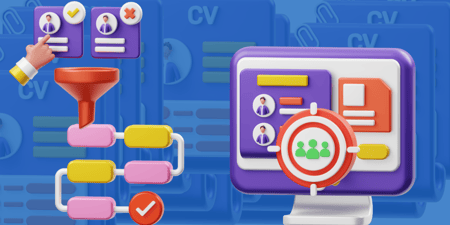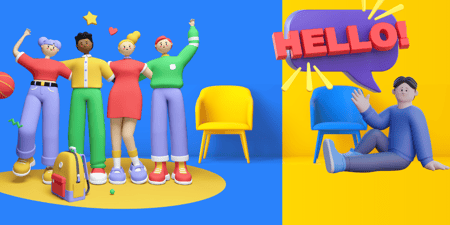Why You Need to Simplify Your Work Processes
Welcome to blog post #1!
 Let's kick things off with a question that might save you some time: While at work, have you ever thought:
Let's kick things off with a question that might save you some time: While at work, have you ever thought:
“This is too easy and straightforward; I think I might be overpaid. Plus, every single thing I do clearly benefits the business in a measurable way.”
OR
“MAN, my company has this business thing DIALED. IN. There’s nothing going on here that’s even a little bit inefficient.”
If you answered “yes” to either of those questions, then congratulations! (but this post probably isn’t for you)
Chances are, you answered “no” to both questions. You might have even chuckled quietly to yourself at how absurd it is to suggest such a workplace exists. The reality for most of us is that the company processes we follow are about as simple as a Rubik’s Cube on steroids. That’s why Lexcan exists today; we help businesses spot complexities and then help simplify them.
Here’s a quick rundown of the main complexity culprits we’re diving into today:
- Too many decision-makers
- Sometimes it feels like having a committee assigned to pick the color of your socks. By the time they get back to you, you’ve already worn flip-flops to work.
- Redundancies
- Businesses love them like a dog loves chasing its tail. And, just like that dog, most businesses don’t know what the heck to do if they actually find a redundancy. Instead, you get to live out Groundhog Day in the form of repetitive meetings.
- Multi-tasking
- One of the greatest myths of our time. Juggling flaming swords while riding a unicycle on a tightrope might sound fun, but it’s not very productive. Trying to multi-task usually just means things fall through the cracks and get done more slowly.
- Policies & Rules
- Too many businesses suffer from policy overload. It’s kind of like untangling a long cable that’s been in your desk for months, but somehow you manage to create new knots in the process.
- SaaS Sprawl
- “There’s an app for that” might be responsible for more headaches in your IT department than worldwide app downloads. Everyone loves to find
a single app for a single problem because that’s the fastest thing to do. Unfortunately, this means most companies end up with more subscriptions than they have employees.

In this post, we dive into these issues and crack open the nutty truth of workplace inefficiency like a squirrel on a caffeine rush.
Too Many Decision-Makers
 Picture yourself organizing a dinner party. Most of the time, you’ll just pick something for everyone to eat, and that’s the end of it. You get to spend the morning happily flipping through your well-worn cookbook and deciding between the hearty lasagna or the fan-favourite chicken casserole.
Picture yourself organizing a dinner party. Most of the time, you’ll just pick something for everyone to eat, and that’s the end of it. You get to spend the morning happily flipping through your well-worn cookbook and deciding between the hearty lasagna or the fan-favourite chicken casserole.
However, for some reason, this time, you’ve decided to add a dash of democracy to your dinner planning. You've invited your friends to weigh in on the food options.
You soon realize just how different everyone’s dietary preferences are.
- Susan is a staunch supporter of plant-based meals and is lobbying for a vegan spread.
- Bill is a committed carnivore and can't imagine a meal without a substantial serving of steak (or some similar meat).
- Jill recently converted to the keto lifestyle and is advocating for low-carb, high-fat dishes.
The night drags on, and suddenly you’re in the middle of a lively debate on the merits of various diets. By the time everyone is nearing some kind of exhausted “agree-to-disagree” agreement, the sun is peeking over the horizon. You watch the sky get brighter, you hear your stomach grumble, and you realize breakfast is now the next logical meal.
Is this situation completely ridiculous? Yes. Does it mirror the workplace chaos we’ve all seen when there are too many decision-makers? Yup. Pick your favorite analogy:
- Too many captains sink the ship.
- Too many cooks spoil the broth.
- Too many barbers turn a haircut into a buzz cut.
- Too many conductors turn Beethoven’s 5th into jazz improv.
- Too many quarterbacks, and you get a football stuck in committee.
Hopefully, you get the idea: too many people trying to make their voices heard without listening to anyone else usually just makes everything fall apart. You wind up with the opposite of smooth progress: a seasick crew, a route that takes twice as long, and a lot of frustration.
Many companies get mixed up between “gathering input” and “giving everyone an equal voice”.
Most leaders live in a happy world where decision-making is always smooth and streamlined. It's as beautiful and orderly as a cascading waterfall, with decisions flowing smoothly down to the rank and file. Everyone knows their role, and the journey from idea to execution is swift and seamless.
Many companies get mixed up between “gathering input” and “giving everyone an equal voice”. It’s even more of a problem when they also forget to figure out who’s actually making the final decision. Other times, whoever’s supposed to make that final decision gets overwhelmed by all the input. When everyone is wielding a decision-making paddle, you'll probably just wind up circling the same issues over and over.
The tricky part is finding a balance between feedback and performance. Decisions have to happen fast, but not if it means plugging your ears when someone tries to offer helpful input.
It’s not easy to solve this, and you’ll probably get stuck in more meetings with too many decision-makers along the way. However, getting to a place where you know the path from idea -> discussion -> input -> decision is well worth the effort.
Redundancies
 Ever watched a dog chase its tail? It's fun for 5 minutes, but then you start to wonder if you should offer to help. Then you wonder if you should have offered to help 4 minutes ago. Redundancies in the workplace are basically the same thing.
Ever watched a dog chase its tail? It's fun for 5 minutes, but then you start to wonder if you should offer to help. Then you wonder if you should have offered to help 4 minutes ago. Redundancies in the workplace are basically the same thing.
We’re talking about repetitive, often boring tasks or systems that don’t provide any apparent value.
Figuring out how to fix redundancies starts with identifying these repetitive tasks. This is tricky because it actually gets harder to do the longer you’ve worked at a company. After a while, everyone starts to go “nose-blind” to redundancies, but they’re still there.
Fun fact: Do you know who the best person is to help you identify this ridiculous repetition? Whoever the newest hire is at your company. Seriously.
Someone trying to learn a new way to do things is going to ask questions and has no idea what “the way we do things around here’ is at your company. This is a great opportunity to solicit as much feedback as possible and find those redundancies! Note: it’s on you (or whoever’s training them) to actually listen and consider whether they have a point!
Personally, I try to automate as many of these redundancies as possible using make.com. If you’re familiar with Zapier, you already get the idea: automate something repetitive without needing to learn how to code. For what it’s worth, I’m a big fan of Zapier, but I find the way make.com lays out things visually makes it easier to keep track of automations involving more than 3-4 steps.
Multi-tasking
 The concept of multitasking, a popular term in business development training, is a myth. Multi-tasking sounds impressive, and we’ve all heard someone at work boast about how good they are at it. Wouldn’t it be great to do several things at the same time (and do them all really well)?
The concept of multitasking, a popular term in business development training, is a myth. Multi-tasking sounds impressive, and we’ve all heard someone at work boast about how good they are at it. Wouldn’t it be great to do several things at the same time (and do them all really well)?
But is it really possible?
 Let’s return to our flaming sword juggler. They’ve now climbed on a unicycle and are starting to slowly make their way across a tightrope. Surely, this is multi-tasking at its best!
Let’s return to our flaming sword juggler. They’ve now climbed on a unicycle and are starting to slowly make their way across a tightrope. Surely, this is multi-tasking at its best!
It’s clear the performer is skilled at doing all of this at the same time. But how well are they performing each skill??
If the performer focused on only the unicycle, perhaps they could go faster and perform amazing tricks on it! Focus on just the tightrope, and they could “spice up” the crossing in some creative ways. Focus on the juggling, and I wonder how many more torches they could juggle at the same time…
Trying to tackle many things at once means doing none of those things as efficiently or as well as possible. The Cleveland Clinic writes, “When our brain is constantly switching gears to bounce back and forth between tasks … we become less efficient and more likely to make a mistake.”
You probably haven’t ridden a unicycle across a tightrope while juggling flaming swords, but you’ve probably tried to multitask while on a video call. And when someone asked you a question, you realized you weren’t actually paying attention to the call.
Managing work processes in the workplace is hard, especially when it comes to figuring out what needs your attention and when. We’re still on the hunt for a “perfect” solution, but business process automation software like monday.com is the best way for us to handle our projects.
The most important thing is figuring out what works best for you and your team and the best ways to cut out multitasking at work. After all, even the most skilled juggler knows the importance of focusing on one ball at a time.
 Policies & Rules
Policies & Rules
Shifting our attention to something every workplace has but few workplaces have mastered: policies, procedures, and rules. These building blocks give your company structure, establish boundaries, define roles, and make sure everything goes smoothly.
Think of how crazy the world would be if traffic lights didn’t exist; I’d call it “a disaster waiting to happen”, but there wouldn’t be much waiting - it would just be a disaster. As annoying as it is that you always hit that one red light that makes you wait 5 minutes when you’re already late, at least you don’t have to worry about other cars slamming into you (as much).
Where most companies lose their way with policies is the business equivalent of putting traffic lights at intersections that only 3 cars drive through every day. It would be pretty silly to see a traffic light at an intersection of 2-lane roads when you’re 200 miles from the nearest city, and it’s been hours since you’ve seen another car. It would be downright annoying if traffic light colors kept changing every few months.
Was the policy for annual leave detailed before or after the policy on proper stapler usage? Or was it sandwiched somewhere between the dress code policy and the guidelines for appropriate email etiquette? Wait, wasn’t there a memo last week saying staplers are banned now? Is this out of date now?
 The constant uncertainty can be disorienting and frustrating, turning what should be a straightforward path into a convoluted journey. Look no further than Pirates of the Caribbean for how to look at policies; they should be “more what you’d call ‘guidelines’ than [unbreakable] rules”. More “coloring book” than a “color-by-numbers book”; you still have structure and guidance, but there’s also room for flexibility within that structure.
The constant uncertainty can be disorienting and frustrating, turning what should be a straightforward path into a convoluted journey. Look no further than Pirates of the Caribbean for how to look at policies; they should be “more what you’d call ‘guidelines’ than [unbreakable] rules”. More “coloring book” than a “color-by-numbers book”; you still have structure and guidance, but there’s also room for flexibility within that structure.
Often, policies become overly complex and restrictive, stifling creativity and innovation. They grow from streamlined guides into complicated novels that control every tiny aspect of working for an organization. They can create a rigid environment that discourages out-of-the-box thinking and promotes a 'this is how we've always done it' mentality.
The trick is to find the right balance for your policies and rules. You need enough structure to keep everything organized and efficient, but you also need to allow room for creativity. It's about having enough traffic lights to prevent accidents but not so many that you're stopping at every corner.
You want something strong and flexible that enhances the company's operations, not a tangled web of rules that confuses and limits everyone. It's a delicate balance but one worth aiming for in the pursuit of a dynamic, efficient, and innovative workplace.
SaaS Sprawl
As we near the end of our walk through the importance of work simplification, we come to a familiar subject (though the name’s a little less well-known): SaaS Sprawl.
 Most of us have heard something like this too many times: “We’re excited to announce that we’re launching a new app to improve group communication! Everyone needs to download it as soon as possible, and please block off 9 am-12 pm every Monday for the next four weeks for onboarding.”
Most of us have heard something like this too many times: “We’re excited to announce that we’re launching a new app to improve group communication! Everyone needs to download it as soon as possible, and please block off 9 am-12 pm every Monday for the next four weeks for onboarding.”
Companies these days are all too eager to sign up for the latest flashy app or platform that promises to “streamline business”, “optimize productivity”, or “revolutionize customer service!” Each application, like a shiny new gadget, is usually acquired with the best of intentions. However, most companies will sign up without thinking through whether it duplicates the functionalities of an existing app, thus adding one more password to remember.
Apple’s “There’s an app for that” campaign is almost 15 years old, but the effects are still very much felt today. Ever use one of those apps that existed just so you could “drink a beer from your phone”? Apps like that exploded in popularity in the late 2000s and early 2010s, including these now-familiar point solutions:
- Dropbox (founded 2007)
- Expensify (founded 2008),
- Twilio (founded 2008)
- Slack (founded 2009),
- Square (founded 2009),
- GroupMe (founded 2010),
- Zoom (founded 2011),
- Trello (founded 2011),
- MileIQ (founded 2012),
- The list goes on!
There’s a good chance that you’ve come across most of these mobile apps/platforms and an even better chance that they weren’t all needed. Point solutions address a single problem, but when too many are thrown together, they can become the problem. Trying to keep track of what app you’re supposed to use for which task creates confusion, increases duplicate work, and wastes money.
Every time you roll out a new app to your company, you’re asking employees to redirect their attention away from something else and learn a whole new system. The result can be like playing Jenga; the goal is to grow, but every time you take one block from the bottom and place it on top, the overall structure becomes less stable.
 All of this skims past the other effects of SaaS Sprawl, like Account Sprawl and Policy Assignment Sprawl, but that’s for another post.
All of this skims past the other effects of SaaS Sprawl, like Account Sprawl and Policy Assignment Sprawl, but that’s for another post.
By the way, fixing SaaS Sprawl (and its knock-on effects) is very doable but probably time-consuming for your company. This Forbes article gives some helpful suggestions for how to evaluate point solutions vs. integrated platforms, and you can also check out our guide on How to Fix SaaS Sprawl for some actions you can start taking today!
So… what’s next?

Well, first off: kudos to you if you’ve made it this far in the article (I’ve been told I have a knack for “using 100 words when 10 will do”).
Jokes aside, the two most common paths usually depend on company size:
- If you have fewer than 50 employees, you might consider small business outsourcing services like ours (and most other small business HR outsourcing companies). However, templates and guides that help you tackle these things yourself may be the best option, and of course, they’re less expensive!
- For bigger companies, the best bang for your buck is almost always outsourced help. You need some fresh eyes and an outside perspective to find all the opportunities and create a plan! Business process automation software like Productiv can come very close to addressing everything we’ve covered today with a single integrated platform; the up-front cost is higher, but for companies with 100s or 1,000s of employees, the savings almost always make up for it.
If you’re somewhere between the two options above, let’s set up a call to talk through what’s most likely to work for you! Your business is unique, and you need a unique plan to help with simplifying it, so if you’re at the start of your “simplify process” journey and have 30 minutes to spare, click here and let’s figure out the next steps together.
.png?width=200&height=80&name=lexcan%20simplify%20work%20banner%20v4%20(200x100).png)






